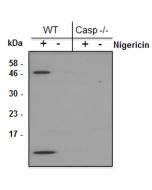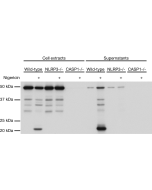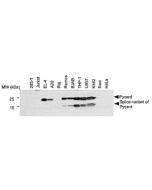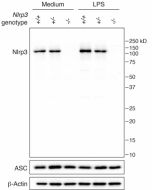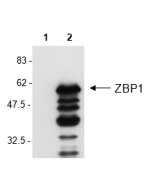Cookie Policy: This site uses cookies to improve your experience. You can find out more about our use of cookies in our Privacy Policy. By continuing to browse this site you agree to our use of cookies.
AdipoGen Life Sciences
anti-NLRC5 (mouse), pAb (IN113)
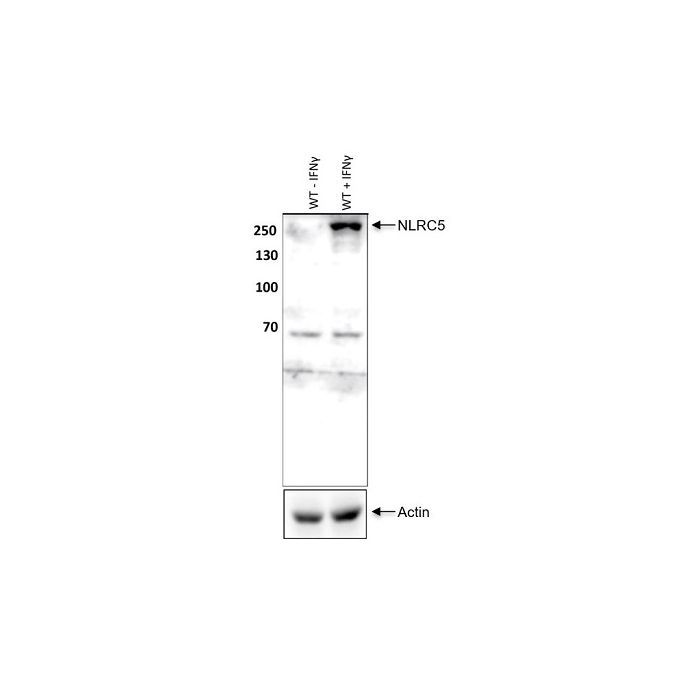
Method: 5x10^6 splenocytes are treated or not with 10ng/ml IFNγ for 16h, separated by SDS-PAGE (8%) under reducing conditions, transferred to nitrocellulose overnight and incubated with anti-NLRC5 (mouse), pAb (IN113) (1:500). Actin antibody (Prod. No. YIF-LF-PA0207) is used as loading control. After addition of an anti-rabbit secondary antibody coupled to HRP (AG-29B-0006E) (1:5000), proteins are visualized by a chemiluminescence detection system. Picture courtesy of Jessica Guerra, lab of Dr. Greta Guarda (Institute of Research in Biomedicine, Bellinzona).
| Product Details | |
|---|---|
| Synonyms | NOD-like Receptor Family CARD Domain Containing 5; Caterpiller Protein 16.1; NOD4; Nucleotide-binding Oligomerization Domain Protein 4 |
| Product Type | Polyclonal Antibody |
| Properties | |
| Source/Host | Rabbit |
| Immunogen/Antigen | Recombinant mouse NLRC5 (CARD domain; aa1-139). |
| Application |
Western Blot: (1:500)* CHIP: (see Reference 1) *Note: We recommend a starting dilution of 1:500 and to optimize the dilution depending on your cells/tissues. |
| Crossreactivity | Mouse |
| Specificity |
Recognizes full-length mouse NLRC5. Does not cross-react with human NLRC5. |
| Purity | ≥95% (SDS-PAGE) |
| Purity Detail | Protein A affinity purified. |
| Concentration | 1mg/ml |
| Formulation | Liquid. In PBS containing 10% glycerol and 0.02% sodium azide. |
| Isotype Negative Control | |
| Other Product Data |
UniProt link C3VPR6: NLRC5 (mouse) |
| Accession Number | C3VPR6 |
| Shipping and Handling | |
| Shipping | BLUE ICE |
| Short Term Storage | +4°C |
| Long Term Storage | -20°C |
| Handling Advice |
After opening, prepare aliquots and store at -20°C. Avoid freeze/thaw cycles. |
| Use/Stability | Stable for at least 1 year after receipt when stored at -20°C. |
| Documents | |
| MSDS |
 Download PDF Download PDF |
| Product Specification Sheet | |
| Datasheet |
 Download PDF Download PDF |
Major histocompatibility complex class I molecules are expressed in all nucleated cells, whereas MHC class II molecules are mostly expressed in hematopoietic cells. The tight regulation of both MHC class I and class II molecules is crucial for eliciting an appropriate immune response. The MHC class II and class I molecule regulation is controlled by class II MHC transactivator (CIITA) and by NLR family caspase recruitment domain-containing 5 (NLRC5), respectively.
NOD-like receptor family CARD domain containing 5 (NLRC5) is the largest member of the NOD-like receptors (NLRs) family. As all NLR-family members, NLRC5 shares a similar protein structure consisting of three main domains: a variable N-terminal protein-interaction domain, a central Nucleotide-Binding Domain (NBD) and a C-terminal stretch consisting of Leucine Rich Repeats (LRRs). NLRC5 contains between its CARD and NBD domain a bipartite-type nuclear localization signal (NLS), allowing NLRC5 transport towards the nucleus. The expression levels of NLRC5 and MHC class I are highly correlated, with more NLRC5 resulting in more MHC class I expression and increased MHC class I cell surface levels. NLRC5 is highly expressed in hematopoietic cells and tissues such as the spleen, lymph node, thymus, intestine, lung and bone marrow. NLRC5 is inducible by interferon-γ (IFN-γ). NLRC5 is decreased in tumor tissues of most cancer types. Lower NLRC5 expression is associated with reduced survival in melanoma, rectal, bladder, uterine, cervical and head/neck cancer.
- NLRC5 Deficiency Selectively Impairs MHC Class I- Dependent Lymphocyte Killing by Cytotoxic T Cells: F. Staehli, et al.; J. Immunol. 188, 3820 (2012)
- NLRC5 Exclusively Transactivates MHC Class I and Related Genes through a Distinctive SXY Module: K. Ludigs, et al.; PLoS Genet. 11, e1005088 (2015)







